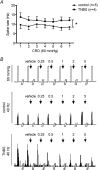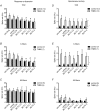TRPV1 receptors on unmyelinated C-fibres mediate colitis-induced sensitization of pelvic afferent nerve fibres in rats
- PMID: 18755744
- PMCID: PMC2652143
- DOI: 10.1113/jphysiol.2008.159731
TRPV1 receptors on unmyelinated C-fibres mediate colitis-induced sensitization of pelvic afferent nerve fibres in rats
Abstract
Patients with inflammatory bowel disease often suffer from gastrointestinal motility and sensitivity disorders. The aim of the current study was to investigate the role of transient receptor potential of the vanilloid type 1 (TRPV1) receptors in the pathophysiology of colitis-induced pelvic afferent nerve sensitization. Trinitrobenzene sulphate (TNBS) colitis (7.5 mg, 30% ethanol) was induced in Wistar rats 72 h prior to the experiment. Single-fibre recordings were made from pelvic nerve afferents in the decentralized S1 dorsal root. Fibres responding to colorectal distension (CRD) were identified in controls and rats with TNBS colitis. The effect of the TRPV1 antagonist N-(4-tertiarybutylphenyl)-4-(3-chlorophyridin-2-yl)tetrahydropyrazine-1(2H)carboxamide (BCTC; 0.25-5 mg kg(-1)) or its vehicle (hydroxypropyl-beta-cyclodextrin) was tested on the afferent response to repetitive distensions (60 mmHg). Immunocytochemical staining of TRPV1 and NF200, a marker for A-fibre neurons, was performed in the dorsal root ganglia L6-S1. TNBS colitis significantly increased the response to colorectal distension of pelvic afferent C-fibres. BCTC did not significantly affect the C-fibre response in controls, but normalized the sensitized response in rats with colitis. TNBS colitis increased the spontaneous activity of C-fibres, an effect which was insensitive to administration of BCTC. TNBS colitis had no effect on Adelta-fibres, nor was their activity modulated by BCTC. TNBS colitis caused an immunocytochemical up-regulation of TRPV1 receptors in the cell bodies of pelvic afferent NF200 negative neurons. TRPV1 signalling mediates the colitis-induced sensitization of pelvic afferent C-fibres to CRD, while Adelta-fibres are neither sensitized by colitis nor affected by TRPV1 inhibition.
Figures





Comment in
-
TRPV1 fans the flames of visceral pain.J Physiol. 2008 Nov 1;586(21):5035. doi: 10.1113/jphysiol.2008.163113. J Physiol. 2008. PMID: 18978157 Free PMC article. No abstract available.
Similar articles
-
TRPV1 receptor signaling mediates afferent nerve sensitization during colitis-induced motility disorders in rats.Am J Physiol Gastrointest Liver Physiol. 2008 Jan;294(1):G245-53. doi: 10.1152/ajpgi.00351.2007. Epub 2007 Nov 8. Am J Physiol Gastrointest Liver Physiol. 2008. PMID: 17991707
-
TLR4 mediates upregulation and sensitization of TRPV1 in primary afferent neurons in 2,4,6-trinitrobenzene sulfate-induced colitis.Mol Pain. 2019 Jan-Dec;15:1744806919830018. doi: 10.1177/1744806919830018. Mol Pain. 2019. PMID: 30672380 Free PMC article.
-
The role of transient receptor potential vanilloid 1 in mechanical and chemical visceral hyperalgesia following experimental colitis.Neuroscience. 2007 Sep 21;148(4):1021-32. doi: 10.1016/j.neuroscience.2007.05.034. Epub 2007 Aug 23. Neuroscience. 2007. PMID: 17719181 Free PMC article.
-
[Immunohistochemical analysis of altered serotonin signaling and transient receptor potential vanilloid 1 channels in experimental colitis mice].Yakugaku Zasshi. 2014;134(11):1165-70. doi: 10.1248/yakushi.14-00189. Yakugaku Zasshi. 2014. PMID: 25366913 Review. Japanese.
-
Research progress in transient receptor potential vanilloid 1 of sensory nervous system.Neurosci Bull. 2009 Aug;25(4):221-7. doi: 10.1007/s12264-009-0506-2. Neurosci Bull. 2009. PMID: 19633705 Free PMC article. Review.
Cited by
-
Sensory Neurons, Neuroimmunity, and Pain Modulation by Sex Hormones.Endocrinology. 2021 Aug 1;162(8):bqab109. doi: 10.1210/endocr/bqab109. Endocrinology. 2021. PMID: 34049389 Free PMC article. Review.
-
Differential Regulation of Bladder Pain and Voiding Function by Sensory Afferent Populations Revealed by Selective Optogenetic Activation.Front Integr Neurosci. 2018 Feb 12;12:5. doi: 10.3389/fnint.2018.00005. eCollection 2018. Front Integr Neurosci. 2018. PMID: 29483864 Free PMC article.
-
Managing pain in inflammatory bowel disease.Gastroenterol Hepatol (N Y). 2011 Sep;7(9):592-601. Gastroenterol Hepatol (N Y). 2011. PMID: 22298998 Free PMC article.
-
Enteric Glia Modulate Macrophage Phenotype and Visceral Sensitivity following Inflammation.Cell Rep. 2020 Sep 8;32(10):108100. doi: 10.1016/j.celrep.2020.108100. Cell Rep. 2020. PMID: 32905782 Free PMC article.
-
Post-inflammatory Abdominal Pain in Patients with Inflammatory Bowel Disease During Remission: A Comprehensive Review.Crohns Colitis 360. 2021 Nov 8;3(4):otab073. doi: 10.1093/crocol/otab073. eCollection 2021 Oct. Crohns Colitis 360. 2021. PMID: 36777266 Free PMC article. Review.
References
-
- Amaya F, Oh-hashi K, Naruse Y, Iijima N, Ueda M, Shimosato G, Tominaga M, Tanaka Y, Tanaka M. Local inflammation increases vanilloid receptor 1 expression within distinct subgroups of DRG neurons. Brain Res. 2003;963:190–196. - PubMed
-
- Banerjee B, Medda BK, Lazarova Z, Bansal N, Shaker R, Sengupta JN. Effect of reflux-induced inflammation on transient receptor potential vanilloid one (TRPV1) expression in primary sensory neurons innervating the oesophagus of rats. Neurogastroenterol Motil. 2007;19:681–691. - PubMed
-
- Blackshaw LA, Gebhart GF. The pharmacology of gastrointestinal nociceptive pathways. Curr Opin Pharmacol. 2002;2:642–649. - PubMed
-
- Cervero F, Laird JM. Visceral pain. Lancet. 1999;353:2145–2148. - PubMed
-
- Costigan M, Woolf CJ. Pain: Molecular mechanisms. J Pain. 2000;1:35–44. - PubMed
Publication types
MeSH terms
Substances
LinkOut - more resources
Full Text Sources
Medical

